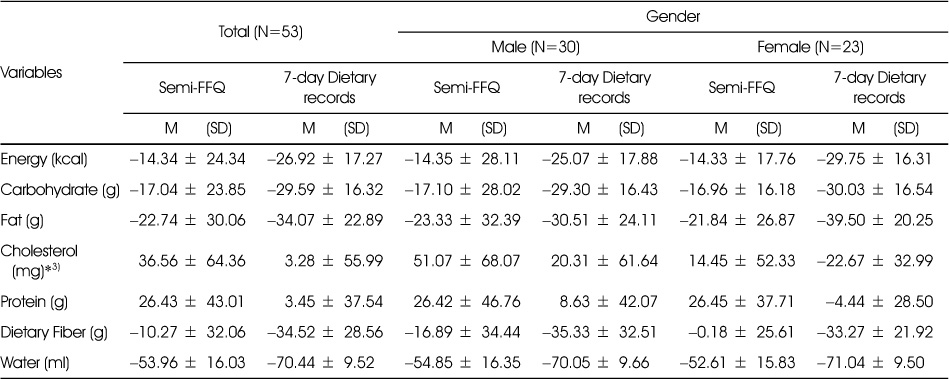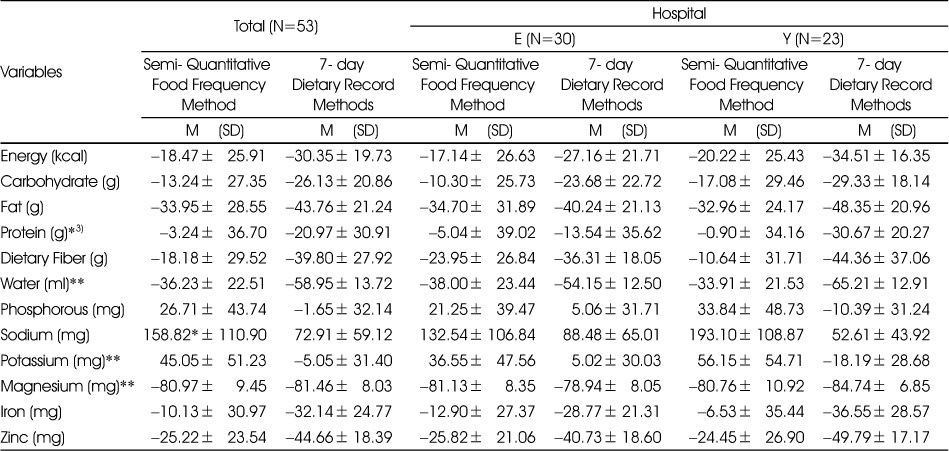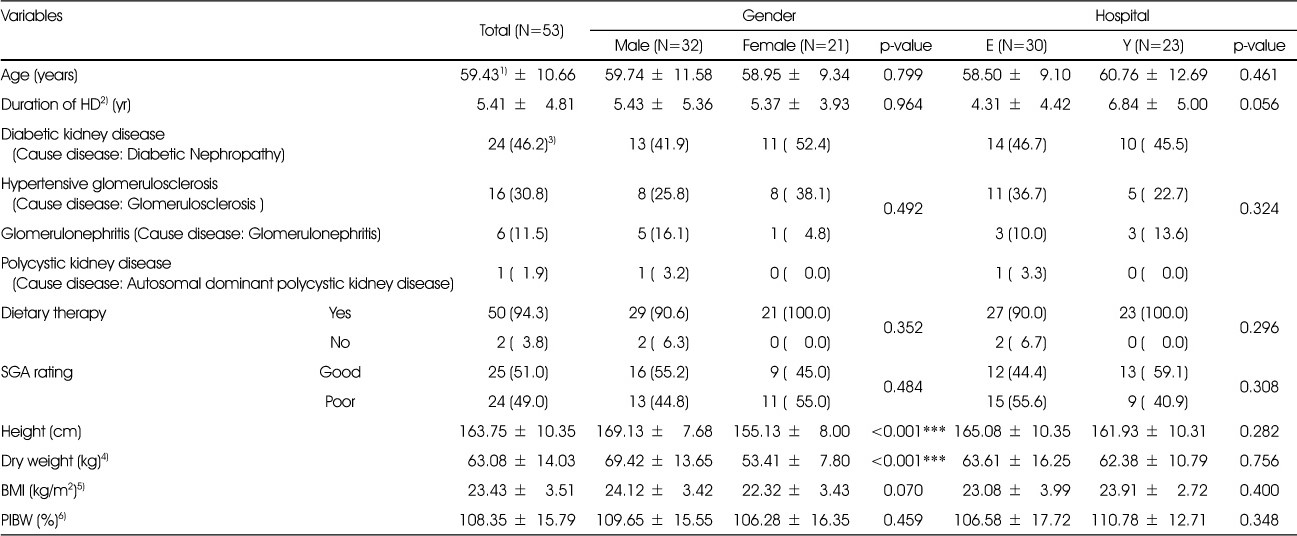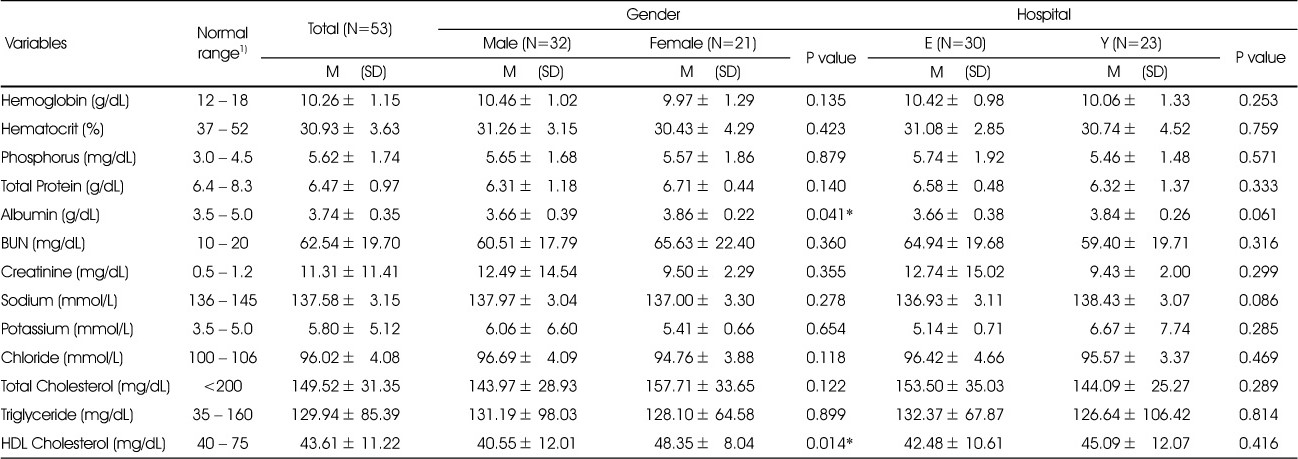Articles
- Page Path
- HOME > Korean J Community Nutr > Volume 22(5); 2017 > Article
-
Research Article
- Comparison Between Semi-Quantitative Frequency Methods and 7-day Dietary Records Methods in Food and Nutrition Intake Status For Hemodialysis Patients
-
Dong-Ryeol Ryu, Jung-Hyun Kim
 , Hyun-Jung Kim, Min-Sook Kyung, Jung-Tak Park
, Hyun-Jung Kim, Min-Sook Kyung, Jung-Tak Park -
Korean Journal of Community Nutrition 2017;22(5):426-440.
DOI: https://doi.org/10.5720/kjcn.2017.22.5.426
Published online: October 31, 2017
1Department of Internal Medicine, School of Medicine, Ewha Womans University, Seoul, Korea.
2Department of Home Economics Education(Major of Food and Nutrition), PaiChai University, Daejeon, Korea.
3College of Nursing, Ewha Womans University, Seoul, Korea.
4Graduate School of Yonsei University, Major of Food and Nutrition, Seoul, Korea.
5Department of Internal Medicine, College of Medicine, Institute of Kidney Disease Research, Yonsei University, Seoul, Korea.
- Corresponding author: Jung-Hyun Kim. Department of Home Economics Education (Major of Food and Nutrition), PaiChai University, 155-40, Baejae-ro, Seo-gu, Daejeon, Republic of Korea. Tel: (042) 520-5424, Fax: (042) 520-5421, jhkim99@pcu.ac.kr
Copyright © 2017 The Korean Society of Community Nutrition
This is an Open-Access article distributed under the terms of the Creative Commons Attribution Non-Commercial License (http://creativecommons.org/licenses/by-nc/3.0/) which permits unrestricted non-commercial use, distribution, and reproduction in any medium, provided the original work is properly cited.
- 826 Views
- 1 Download
- 2 Crossref
Abstract
-
Objectives
- The valid assessment of food and nutrients intakes using appropriate dietary intake method is necessary to improve the nutritional status of the hemodialysis (HD) patients. This study was conducted to compare the method between newly developed, semi-quantitative food frequency questionnaire (Semi-FFQ) and 7-day dietary records (7-DRs) for hemodialysis patients.
-
Methods
- We conducted both methods on 53 maintenance HD patients in two university hospitals. We calibrated the frequency, portion size and daily intake of 47 food items reported in Semi-FFQ. The food and nutrients intake was compared and the correlation of the two methods was analyzed. Also each nutrient intake was compared to recommended dietary allowance for Korean (KDRIs) and recommended nutrient reference value for HD patients.
-
Results
- Energy and energy-yielding nutrients intakes were significantly higher in the two methods (p<0.01). These support the possible reliability between Semi-FFQ and 7-DRs that is similar with regard to most mineral and vitamin intakes. Thus, the Semi-FFQ used in this study for the assessment of nutrient intakes of HD patients can be reliable for the assessment of the nutrient intake along with the 7-DRs. The correlation coefficients were higher for foods consumed daily, such as steamed rice, meat and chicken, bean, egg, milk, coffee and alcohol than for those of foods eaten rarely (p<0.01).
-
Conclusions
- The Semi-FFQ used in this study can be a reliable tool for the assessment of the HD patients' nutrient intake along with the 7-DRs, despite its limitations.
Acknowledgments
Acknowledgments
- 1. The Korean Society of Nephrology. Korean ESRD registry 2017 [Internet]. The Korean Society of Nephrology; 2017; cited 2017 May 23]. Available from: www.ksn.or.kr/.
- 2. Kim SH, Kim SB. Characteristics in nutritional status of patients on hemodialysis and continuous ambulatory peritoneal patients in Chonbuk area. Korean J Nutr 2003; 36(4): 397-404.
- 3. Lee J, Kim JM, Kim YR. Association of diet-related quality of life with dietary regimen practice, health-related quality of life, and gastrointestinal symptoms in end-stage renal disease patients with hemodialysis. Korean J Nutr 2013; 46(2): 137-146.Article
- 4. Chang YK, Jin YG, Park HC. Dietary evaluation and protein catabolic rate in maintenance hemodialysis patients. Korean J Nutr 1992; 25(3): 256-263.
- 5. Lee YJ, Lee YJ, Oh IH, Lee CH, Lee SS. Comparative study of serum levels of albumin and hs-CRP in hemodialysis patients according to protein intake levels. J Nutr Health 2013; 46(6): 521-530.Article
- 6. Ahmed K, Kopple J. Nutritional management of renal disease. San Diego, CA: Academic Press; 1994. p. 289.
- 7. Ikizler IA. Nutrition and kidney disease. Philadelphia: Elsevier; 2005. p. 496.
- 8. Seo HJ. A study on effect of nutrition education in hemodialysis patients [master's thesis]. Changwon's University; 2002.
- 9. Kim SM, Lee YS, Cho DK. Nutritional assessment of the hemodialysis patients. Korean J Nutr 2000; 33(2): 179-185.
- 10. Woo HJ, Lee YJ, Oh IH, Lee CH, Lee SS. Association of food intake with serum levels of phosphorus and potassium in hemodialysis patients. J Nutr Health 2014; 47(1): 33-44.Article
- 11. Murphy SP, Poos MI. Dietary reference intakes: Summary of applications in dietary assessment. Public Health Nutr 2002; 5(6A): 843-849.ArticlePubMed
- 12. Pietinen P, Hartman AM, Haapa E, Räsänen L, Haapakoski J, Palmgren JK, et al. Reproducibility and validity of dietary assessment instruments. Am J Epidemiol 1988; 128(3): 667-676.ArticlePubMed
- 13. Souverein OW, Dekkers AL, Geelen A, Haubrock J, de Vries JH, Ocke MC, et al. Comparing four methods to estimate usual intake distributions. Eur J Clin Nutr 2011; 65: S1. S92-S101.ArticlePubMedPDF
- 14. Ahn Y, Kwon E, Shim JE, Park MK, Joo Y, Kimm K, et al. Validation and reproducibility of food frequency questionnaire for Korean genome epidemiologic study. Eur J Clin Nutr 2007; 61(12): 1435-1441.ArticlePubMedPDF
- 15. Cho YE, Lee SL, Cho EH, Lomeda RAL, Kwak EH, Kim YH, et al. Comparison of nutrient intakes of Korean elderly people living in rural area between 24-hour recall and food frequency method. J Korean Soc Food Sci Nutr 2006; 35(6): 698-707.Article
- 16. Lee SY, Ju DL, Paik HY, Shin CS, Lee HK. Assessment of dietary intake obtained by 24-hour recall method in adults living in Yeonchon area (1): Assessment based on nutrient intake. Korean J Nutr 1998; 31(3): 333-342.
- 17. Lee JY, Kim DW. Validation of food intake frequency from food frequency questionnaire for use as a covariate in a model to estimate usual food intake. Culin Sci Hosp Res 2017; 23(2): 64-73.Article
- 18. The Korean Nutrition Society. CAN-Pro4.0 [Internet]. The Korean Nutrition Society; 2011; cited 2011 Nov 24]. Available from: http://www.kns.or.kr/.
- 19. Rural Development Administration. Korean Food Composition Table (9th revision) [Internet]. Rural Development Administration; 2017; cited 2017 Jun 30]. Available from: http://www.rda.go.kr/.
- 20. Lee JW, Lee MS, Kim IH, Son SM, Lee BS. Nutrition Assessment. Gyomunsa; 2009. p. 100-201.
- 21. The Korean Dietetic Association. Manual of medical nutrition therapy [Internet]. Korean Dietetic Association; 2008; cited 2008 Sep 01]. Available from: www.dietitian.or.kr/.
- 22. Lee JH, Lee YI, Choi JH, Lee HJ, Shin DH, Lee EJ. Association between waist-to-height ratio and metabolic risk factors in Korean adults with overweight body mass index: Korean National Health and Nutrition Examination Survey, 2010-2012. Korean J Fam Pract 2017; 7(1): 125-130.Article
- 23. Yun SH, Shim JS, Kweon S, Oh K. Development of a food frequency questionnaire for the Korea National Health and Nutrition Examination Survey: data from the fourth Korea National Health and Nutrition Examination Survey (KNHANES IV). Korean J Nutr 2013; 46(2): 186-196.Article
- 24. The Korean Nutrition Society. 2015 Korean Dietary Reference for Koreans (KDRIs). Seoul: The Korean Nutrition Society; 2015.
- 25. Park JK, Son SM. Nutritional status of continuous ambulatory peritoneal dialysis patients. Korean J Nutr 2006; 39(7): 624-640.
- 26. Kim YH, Seo HJ, Kim SR. A study of the nutritional status, nutritional knowledge, and dietary habits of the hemodialysis patients. Korean J Nutr 2001; 34(8): 920-928.
- 27. Kim JY, Oh SY, Lee HB. Evaluation of dietary behavioral factors related to nutritional status of hemodialysis patients. Korean J Community Nutr 2001; 6(5): 972-973.
- 28. Bae NY. Relationship between self-efficacy, salty taste sensitivity, salty taste and low salt diet in patients with chronic kidney disease [master's thesis]. Ewha Woman's University; 2017.
- 29. Lee HS, Lee SY. Nutrient intake status and relevant factors of hemodialysis patients hospitalized in general hospital located in Daejeon. Korean J Hum Ecol 2016; 25(1): 55-71.Article
- 30. Kim MJ, Park CN, Kang YE, Lee SS. The effects of nutrition education and regular exercise on nutritional status, quality of life and fatigue in hemodialysis patients. J Korean Diet Assoc 2013; 19(4): 373-388.Article
- 31. Park OL, Jang YJ, Jung JH, Kim SR. Factors affecting malnutrition in hemodialysis patients. Korean J Adult Nurs 2016; 28(2): 226-236.ArticlePDF
- 32. Park KA, Sim YM, Kim SB, Choi SM. A study of the nutritional status and its related factors in the elderly hemodialysis patients. Korean J Nutr 2006; 39(2): 133-144.
- 33. Kim HW, Choi SM. Structural equation modeling on quality of life in pre-dialysis patients with chronic kidney disease. J Korean Acad Nurs 2012; 42(5): 699-708.ArticlePubMed
- 34. Jung YJ, Park YS, Kim HS, Jang YK, Kim C. Evaluation of nutrient intakes in the hemodialysis patients according to the socioeconomic status: in Daejeon and Chungnam areas. Korean J Nutr 2002; 35(5): 544-557.
- 35. Kim BM. Seasonal variations of nutritional intake in patients on hemodialysis [master's thesis]. Hanyang's Univercity; 2015.
- 36. Date C, Fukui M, Yamamoto A, Wakai K, Ozeki A, Motohashi Y, et al. Reproducibility and validity of a self-administered food frequency questionnaire used in the JACC study. J Epidemiol 2005; 15: S1. S9-S23.ArticlePubMedPMC
- 37. Tokudome S, Imaeda N, Tokudome Y, Fujiwara N, Nagaya T, Sato J, et al. Relative validity of a semi-quantitative food frequency questionnaire versus 28 day weighed diet records in Japanese female dietitians. Eur J Clin Nutr 2001; 55(9): 735-742.ArticlePubMedPDF
- 38. Deschamps V, de Lauzon-Guillain B, Lafay L, Borys JM, Charles MA, Romon M. Reproducibility and relative validity of a food-frequency questionnaire among French adults and adolescents. Eur J Clin Nutr 2009; 63(2): 282-291.ArticlePubMedPDF
- 39. Suk YM, Park JW, Jeon MJ, Kim CY. Effect of periodic video education on knowledge about hemodialysis, patient role behavior and the physiologic index in patients with hemodialysis. J Korean Biol Nurs Sci 2013; 15(3): 122-132.Article
- 40. Lee YM, Lee YK. Effectiveness of nutrition education and counseling on the salty taste assessment, nutrition knowledge and dietary attitude of hemodialysis patients. Korean J Community Nutr 2013; 18(4): 402-412.
REFERENCES
Nutrient intake status (%): calories, calories nutrients, dietary fiber, water intake correlation

Percentage of KDRIs1) of the subjects: energy, macronutrients, cholesterol and dietary fiber intakes in male and femalehemolysis patients

Percentage of KDRIs1) of the subjects: vitamin and minerals intakes in male and female hemolysis patients

Percentage of kidney patient nutrient intake standard contrast1) of the subjects

1) Reference source: Overview of the management of chronic kidney disease in adults, *Data from: 1. Ahmed K, Kopple J. Nutritional management of renal disease. In: Primer on Kidney Diseases, Greenberg A (Ed). Academic Press, San Diego, CA, 1994, p.289. 2. Ikizler IA. Nutrition and kidney disease. In: Primer on Kidney Diseases, Greenberg A (Ed). Elsevier, Philadelphia, 2005, p.496.
2) Unit=%
3) *: p<0.05, **: p<0.01
Figure & Data
REFERENCES
Citations

- Comparison of dietary intake patterns in hemodialysis patients by nutritional status: A cross-sectional analysis
Ji Eun Lee, Hyun-Jung Kim, Mi Jung Lee, Young Eun Kwon, Min-Sook Kyung, Jung-Tak Park, Jung Pyo Lee, Su-Hyun Kim, Jung-Hyun Kim, Hyung Jung Oh, Dong-Ryeol Ryu
Kidney Research and Clinical Practice.2020; 39(2): 202. CrossRef - Comparison of hemodialysis and peritoneal dialysis patients’ dietary behaviors
Seon-Mi Kim, Byung Chin Kang, Hyun-Jung Kim, Min-Sook Kyung, Hyung Jung Oh, Jung-Hyun Kim, Oran Kwon, Dong-Ryeol Ryu
BMC Nephrology.2020;[Epub] CrossRef
General characteristics of the hemolysis patients
1) Mean±SD
2) HD: hemodialysis
3) N (%)
4) Post-dialytic weight
5) BMI: body mass index=weight (kg)/height (m2)
6) PIBW: percent ideal body weight=weight (kg)/standard weight (kg)*100
Biochemical examination (Hematology, Blood chemistry, Lipid tests)
1) Nutrition therapy and pathophysiology, Cengage Learning, Nelms, 2012.
2) Unpaired Student's t-test was used to compare between male and female groups and significantly different between two groups at * p<0.05
Nutrient intake status (%): calories, calories nutrients, dietary fiber, water intake correlation
1) Pearson's correlation coefficient test was used to assess the correlation coefficient between 24-hrs recall and food frequency questionnaire and significantly correlated at *: p<0.05, **: p<0.01, ***: p<0.001
Nutrient intake status (%): vitamins and minerals
1) Pearson's correlation coefficient test was used to assess the correlation coefficient between 24-hrs recall and food frequencyquestionnaire and significantly correlated at *: p<0.05, **: p<0.01, ***: p<0.001
Food intake frequency
1) Pearson's correlation coefficient test was used to assess the correlation coefficient between 24-hrs recall and food frequencyquestionnaire and significantly correlated at *: p<0.05, **: p<0.01, ***: p<0.001
2) Frequency of daily intake.
Percentage of KDRIs1) of the subjects: energy, macronutrients, cholesterol and dietary fiber intakes in male and femalehemolysis patients
N. S.
1) Reference source: Dietary Reference Intakes For Koreans 2015.
2) Unit=%
3) *: p<0.05
Percentage of KDRIs1) of the subjects: vitamin and minerals intakes in male and female hemolysis patients
N. S.
1) Reference source: Dietary Reference Intakes For Koreans 2015.
2) Unit=%
3) *: p<0.05, **: p<0.01
Percentage of kidney patient nutrient intake standard contrast1) of the subjects
1) Reference source: Overview of the management of chronic kidney disease in adults, *Data from: 1. Ahmed K, Kopple J. Nutritional management of renal disease. In: Primer on Kidney Diseases, Greenberg A (Ed). Academic Press, San Diego, CA, 1994, p.289. 2. Ikizler IA. Nutrition and kidney disease. In: Primer on Kidney Diseases, Greenberg A (Ed). Elsevier, Philadelphia, 2005, p.496.
2) Unit=%
3) *: p<0.05, **: p<0.01
1) Mean±SD 2) HD: hemodialysis 3) N (%) 4) Post-dialytic weight 5) BMI: body mass index=weight (kg)/height (m2) 6) PIBW: percent ideal body weight=weight (kg)/standard weight (kg)*100
1) Nutrition therapy and pathophysiology, Cengage Learning, Nelms, 2012. 2) Unpaired Student's t-test was used to compare between male and female groups and significantly different between two groups at * p<0.05
1) Pearson's correlation coefficient test was used to assess the correlation coefficient between 24-hrs recall and food frequency questionnaire and significantly correlated at *: p<0.05, **: p<0.01, ***: p<0.001
1) Pearson's correlation coefficient test was used to assess the correlation coefficient between 24-hrs recall and food frequencyquestionnaire and significantly correlated at *: p<0.05, **: p<0.01, ***: p<0.001
1) Pearson's correlation coefficient test was used to assess the correlation coefficient between 24-hrs recall and food frequencyquestionnaire and significantly correlated at *: p<0.05, **: p<0.01, ***: p<0.001 2) Frequency of daily intake.
N. S. 1) Reference source: Dietary Reference Intakes For Koreans 2015. 2) Unit=% 3) *: p<0.05
N. S. 1) Reference source: Dietary Reference Intakes For Koreans 2015. 2) Unit=% 3) *: p<0.05, **: p<0.01
1) Reference source: Overview of the management of chronic kidney disease in adults, *Data from: 1. Ahmed K, Kopple J. Nutritional management of renal disease. In: Primer on Kidney Diseases, Greenberg A (Ed). Academic Press, San Diego, CA, 1994, p.289. 2. Ikizler IA. Nutrition and kidney disease. In: Primer on Kidney Diseases, Greenberg A (Ed). Elsevier, Philadelphia, 2005, p.496. 2) Unit=% 3) *: p<0.05, **: p<0.01

 KSCN
KSCN




 PubReader
PubReader Cite
Cite


